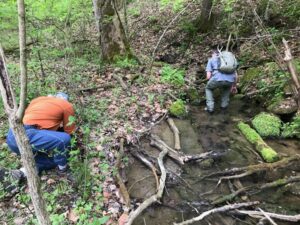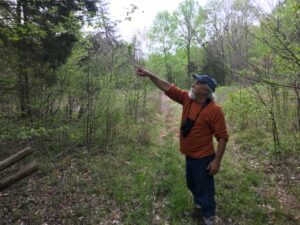By bernheim
–By Dr. Barney Schlinger and Dr. Mark Wourms

“Stop the car…there’s the first Whipporwill of the Spring. Wait, there are several calling” “There’s the first Chimney Swift, and Eastern Kingbird and Yellow-breasted Chat and Common Yellowthroat”. This was the way our morning went on our 6 am bird walk/survey of the Cedar Grove Wildlife Corridor. This is the habitat where LG&E/PPL proposes breaking a conservation easement to take Bernheim land for a proposed natural gas pipeline. Director of Conservation Andrew Berry, and Natural Areas Manager Evan Patrick and I, listened as Ornithologist in Residence Dr. Barney Schlinger called out many of the spring migrants by noting their songs. Dr. Schlinger, visiting from UCLA, Department of Life Sciences, worked at Bernheim during April surveying birds, updating Bernheim’s bird list, editing manuscripts and delivering two dynamic Zoom presentations on control mechanisms and evolution of bird song and dance. Click the links below to view the presentations:
Language and the Brains of Birds and Humans

During our survey of the proposed pipeline route, we crossed through open agriculture field converted to acres of pollinator habitat, oak/hickory forest on the ridges, as well as wetter riparian habitat. We saw or heard (mostly) 33 bird species (plus 3 unsure birdsongs). Not bad for early spring, particularly since we were also, looking down at flowers, turning over stones looking for salamanders, discussing the numerous snail species, examining box turtles, and just enjoying the warmest morning since last October.

“Kentucky is a really special place for birds, occupying the western edge of the great eastern deciduous forest biome, the Mississippi and Ohio River drainages as well as being the southern end of the range of many northern species and the northern end of the range for many southern species” stated Dr. Schlinger. “And even for Kentucky, Bernheim is really special given its diversity of habitats, including knobs, rocky ravines, meadows, and streams, most of which have been unspoiled for so many years that the forest has been able to mature nicely creating habitat for songbirds, golden eagles and endangered bat species” added Andrew Berry. Of course, the trees have matured so well that “warbler neck” is a common problem with bird watchers here because these beautiful small birds often occupy the upper reaches of the tallest trees. The forest was still fairly quiet this late April morning for we saw or heard only one individual for many of the migrant species of the list. That made it all the more compelling, however, because we just knew that more birds would be arriving every day for the next few weeks, some just passing through, but many staying to breed. The dawn song chorus will be a real treat by May’s end.
April 28 6:15 to 9:15am
- Sharp-shinned Hawk
- Turkey Vulture
- Black Vulture
- Mourning Dove
- Whippoorwill
- Chimney Swift
- Red-bellied WP
- Hairy Woodpecker (?)
- Eastern Kingbird
- Eastern Wood Pewee
- Acadian Flycatcher
- Alder Flycatcher
- Carolina Chickadee
- Tufted Titmouse
- Blue Jay
- Wood Thrush
- American Robin
- Red-eyed Vireo
- White-eyed vireo
- Warbling vireo
- Blue-headed vireo (?)
- Yellow-breasted Chat
- Chestnut-sided warbler
- Black and white warbler
- Blackburnian Warbler
- Common Yellowthroat
- Ovenbird
- Hooded warbler (?)
- Black-throated green Warbler
- Parula warbler
- Field Sparrow
- Song sparrow
- Eastern Towhee
- Scarlet Tanager
- Cardinal
- Common Goldfinch

